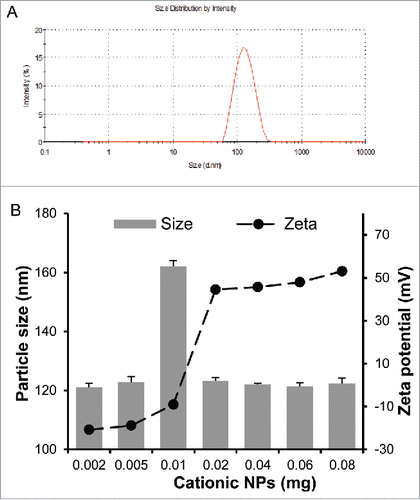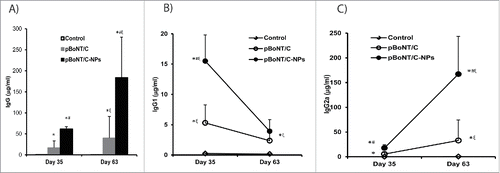Figures & data
Figure 1. (A) Representative dynamic light scattering spectrum of typical PLGA nanoparticles. (B) The size and zeta potential of pVax/Opt-BoNT/C-Hc50-coated cationic PLGA nanoparticles at various nanoparticles to plasmid ratios. Increasing amounts of cationic nanoparticles (0.002–0.08 mg) were mixed with a fixed amount of DNA (1 µg) in equal volumes and allowed to incubate at room temperature for at least 30 min before measuring size and zeta potential. All data reported are mean ± SEM (n = 3).

Figure 2. Serum anti-BoNT/C-Hc50 IgG (A), IgG1 (B), and IgG2a(C) induced by intramuscular immunization of mice with pVax/opt-BoNT/C-Hc50 (20 µg/mouse), alone (i.e., pBoNT/C) or coated on cationic PLGA nanoparticles (i.e., pBoNT/C-NPs). SKH-1 Elite mice (n = 5) were dosed in weeks 0, 2, 4 and 8. Control mice received PBS only. Blood samples were collected in week 5 (day 35) and week 9 (day 63). Data are mean ± SD (n = 5). *p < 0.05 compared to Control group,#p < 0.05 compared to pBoNT/C only, and ξp < 0.05, day 35 vs. day 63.

Figure 3. Protective immunity against BoNT/C challenge in immunized mice. SKH-1 Elite mice (n = 5) were dosed in weeks 0, 2, 4 and 8 with pVax/opt-BoNT/C-Hc50 plasmid (20 µg per mouse), alone (i.e., pBoNT/C) or coated on PLGA nanoparticles (i.e., pBoNT/C-NPs), with control mice receiving PBS only, and challenged in week 12 with 100 × MLD50 of BoNT/C toxin.

